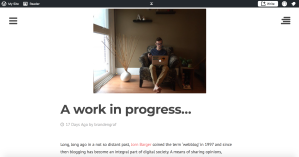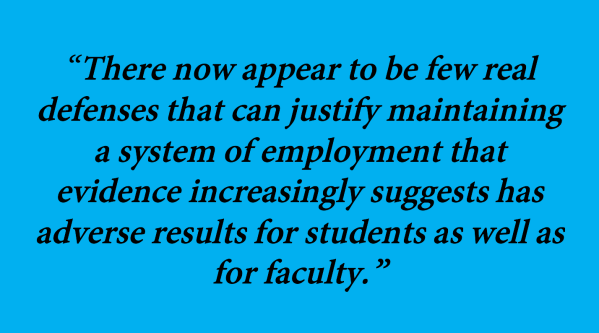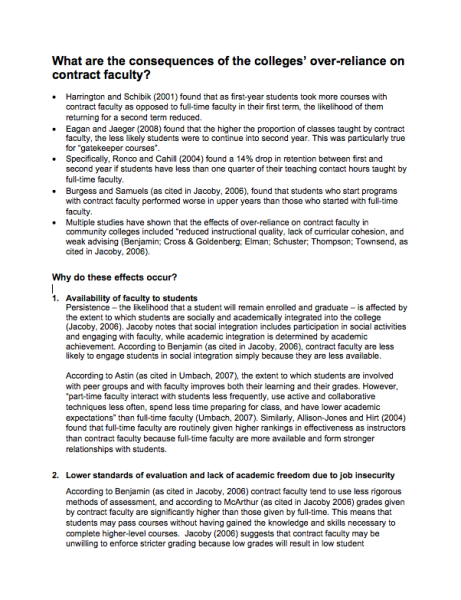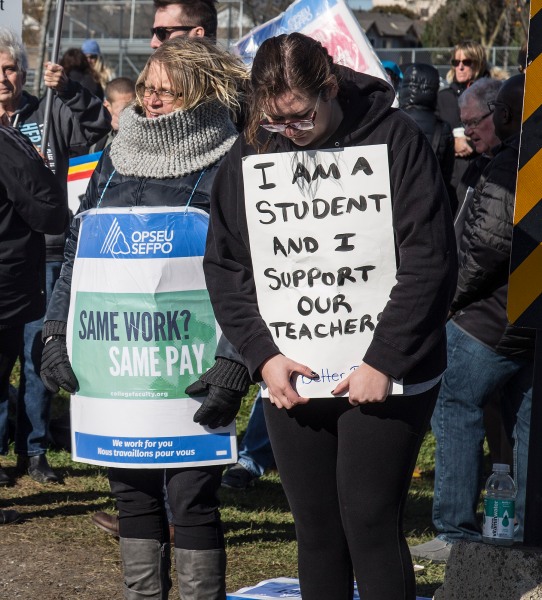The post below is copied from my “About Me” page from a few months ago. With the college faculty strike over, it’s time to restore my old profile page. However, I didn’t want to lose the commentary below.
—-
I am an ardent full-time professor of business fundamentals at St. Lawrence College in Kingston, Ontario, Canada, and I have been on strike since Oct. 16 with about 12,000 other college faculty.
In my previous career as a newspaper journalist in England; Nova Scotia; and here in Kingston, Ontario, I covered plenty of strikes with a journalist’s dispassionate, objective voice. Strikes were something that happened to other people.
I also didn’t understand strikes. After all, as a young, mobile professional, it was my view that if you couldn’t fix a poor employment situation, you should leave. And if you were good at what you did, someone better than the previous employer would hire you.
 But that viewpoint ends when one becomes invested in one’s community and clients. In my case, it is the city of Kingston and my students.
But that viewpoint ends when one becomes invested in one’s community and clients. In my case, it is the city of Kingston and my students.
I left my full-time newspaper job of 10 years in 2008 to teach 12 hours per week at the college’s business school while running my own corporate communications business.
It was tough going. My business—Wordstrong Consulting—took off almost immediately and became a full-time job. By the end of my first semester at St. Lawrence College, I was working 7 days and 70 hours a week. Teaching was exhausting, but I loved it—even though I sucked at it at first.
I remember going into my first Office Administration communications classes and hearing the students angrily complaining about me. I think a few even brought their concerns about my competence to our associate dean.
It hurt to be thought of as inadequate. I was giving an A-plus effort and delivering to students a D-minus education. As a professional writer, it had been a long time since I’d been anything less than excellent. It was demoralizing and I felt tremendously guilty that my student-clients were not getting a stellar product from me.
For me, back then, in 2008, there was a light at the end of the tunnel. At the time, the ratio of full-time instructors to part-time instructors was about the opposite of what it is now (it was about 70% full-time to 30% part-time, whereas now it is about 19% full-time to 81% part-time).
I knew that if I worked really hard, I would become an excellent instructor and I would eventually earn one of those coveted full-time positions. It took six years of working every day—including weekends—and skipping holidays, like Christmas and the winter break, to get there. Working every day was hard on the relationship with my wife and even influenced our decision to have only one child. Each year, my wife and I would evaluate whether or not I should continue at the college. Indeed, I almost quit the year before I won a full-time position.
Now in my fourth year as a full-time professor, I still work at least one day most weekends, most of the Christmas holidays, and over the winter breaks. But that’s OK. Teaching at the college level is the best job in the world: I build meaningful connections with my students (my clients) and I have real impact on their lives—all the while continually growing and learning through self-reflection and from my students.
I am humbled at the honour to have been given a chance at this great vocation. But if the ratio of part-time to full-time instructors had been, in 2008, as it is now, I don’t think I would have stuck it out more than a year because there would have been no light at the end of that tunnel.
Then, do you know what would have happened? Another bright-eyed keener would have replaced me: another passionate instructor who would have given an A-plus effort while delivering D-minus learning for a year or so before burning out and being replaced by another.
So, it’s for my students, who deserve an A-plus learning experience, that I am out here on the picket line day after day, drawing a line in the sand in hopes that Ontario colleges will return to the bargaining table, stop the cycle of education deterioration, and give our student-clients their money’s worth.
-30-
Inspired by my colleague Melanie Christian, who recently created a blog to write about the strike and the issues surrounding it, I have decided to resurrect my own teaching blog. I will be posting about my experiences on the picket line and beyond here. Stay tuned.


 A local food pilot program that delivers fresh produce at affordable prices to those in need will continue for another year.
A local food pilot program that delivers fresh produce at affordable prices to those in need will continue for another year.



 ability to grab attention. No one could argue that her headline (“Three posts deep in the blogging trenches”) and her introduction (“I was that kid that would pull the
ability to grab attention. No one could argue that her headline (“Three posts deep in the blogging trenches”) and her introduction (“I was that kid that would pull the  starts her post with a startling statistic. She tops her post with a well-placed—skillfully cited through a hyperlink—banner image that stretches aesthetically across the entire post. She also makes use of a numbered list and bold-face text to make her post imminently scannable and easy on the eyes.
starts her post with a startling statistic. She tops her post with a well-placed—skillfully cited through a hyperlink—banner image that stretches aesthetically across the entire post. She also makes use of a numbered list and bold-face text to make her post imminently scannable and easy on the eyes. images. Most students provided the minimum single image. But Branden has two embedded into his blog and a photo of himself at the top of his post. I like the personal effort. I also love Branden’s intro, which kicks off his post with a brief history of blogging.
images. Most students provided the minimum single image. But Branden has two embedded into his blog and a photo of himself at the top of his post. I like the personal effort. I also love Branden’s intro, which kicks off his post with a brief history of blogging. Danielle Cormier-Serre
Danielle Cormier-Serre also like Sarah’s call to action: “But what do you think? Is there something more important that would make my blog, or any blog, better?” Thank you, Sarah. I hope you get some feedback.
also like Sarah’s call to action: “But what do you think? Is there something more important that would make my blog, or any blog, better?” Thank you, Sarah. I hope you get some feedback.

 But that viewpoint ends when one becomes invested in one’s community and clients. In my case, it is the city of Kingston and my students.
But that viewpoint ends when one becomes invested in one’s community and clients. In my case, it is the city of Kingston and my students.







